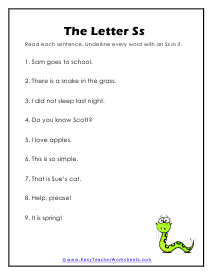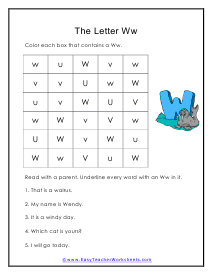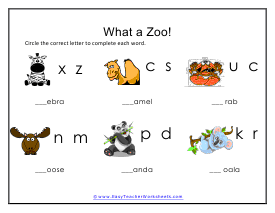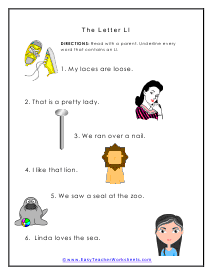These worksheets will teach your beginning readers how to recognize specified letters. Activities include letter mazes, identifying the specified letters within a story, matching lower case letters to the correct upper case equivalents, matching the correct pictures to word clues, coloring letters according to the given instructions, and choosing the correct letter to complete a given word based on picture clues. It is amazing how we take for granted that these symbols we call letters actual mean something when put together in a different pattern. It’s even more amazing that these letter groups (words) help us communicate ideas and human capital over years and years. Take a look at a language that is foreign to you. Do you understand their symbols? If you scroll down, you will see find a ton of fun worksheets that will help students become much more familiar with the letters of the alphabet.
Printable Recognizing Letters Worksheets
Click the buttons to print each worksheet and answer key.

Tt Turtle Path
Turtle is trying to find his way back to his pond. Draw a path from Turtle to the pond by following the letter Tt.



Baby's Crib Letter Maze
Help the baby find his crib. Draw a path from the baby to his crib by following the letter Tt.

Upper and Lower Case
Help the baby find his crib. Draw a path from the baby to his crib by following the letter Tt.

Gg is for...
Match the picture to the word with the missing Gg. Fill in the letter on the line. Then color the picture.









The foundation of being able to communicate in written language is the alphabet. This where learning to read and write is all shaped. Two-year olds will often be able to begin to learn their letters, although others make take longer to mature. Before students can begin to recognize words and form words of their own a series of basic alphabetic skills must be mastered. It usually starts with the Alphabet Song and then projects forward from there. The next step is helping students be able to identify all the individual letters. It is best to focus solely on lower case letters at first and after students have a good handle on the idea, advance to the upper case. Having spent over ten years at the early primary grade levels I can tell you that each teacher approached the order of teaching the letters in all types of different ways. I would say half of the teachers present the letters to students it in sequential alphabetic order. The remaining teachers will either present them in usage patterns either based on the models their language program has put together for them or by their own theories that they have had success with.
How to Teach the Letters of the Alphabet?
Reading is one of the essential milestones for preschool kids. Before teaching them how to read, kids need to be taught the alphabet – recognizing the letter shapes, identifying the names of the letters, and pronouncing the letter sounds.
Why Is It Important?
Learning how to speak, read, and write the English language begins with letter or alphabet recognition. Alphabet recognition will pave the way to reading words which will then help with making sentences, then paragraphs, stories, books, and so forth.
If you keep the curriculum fun and engaging and incorporate multi-leveled activities, kids are likely to learn the alphabet at a good pace. Approaching a topic from different angles makes it easy to retain, process, and master it.
Using only a book or a worksheet may not work for a class full of students. A child drawing the letter in the sand, forming it with playdough, making it through a craft, or finding it among a stack of blocks will help this information stay in their minds for a long time.
Games, poems, actions, and activities make the otherwise tedious task of learning entertaining, to say the least.
Here are a few ways you can use to help your kids or students to learn the alphabet.
1. Reading Alphabet Books
Reading can begin as early as when the kid in question is a baby! The consistent repetition ensures your child will be able to recognize and learn the letters of the alphabet from a very young age.
2. Playing with Alphabet Puzzles
Alphabet puzzles are one of the many amazing tools that teach the letters of the alphabet. Wooden puzzles, blocks, and pictures help kids practice their verbal skills and vocabulary.
3. Sensory Activities
All kids have their own learning pace when it comes to recognizing alphabets. A guaranteed way to teach kids about the letters of the alphabet is by giving them multisensory experiences. Repeated exposure through sensory play creates meaningful experiences for kids, and they start recognizing and writing the letters sooner.
4. Enforcing the Concept through Activities
- Introduce the letters by reading colorful alphabet books.
- Use online resources to watch videos, songs, and poems focused on the shape and sound of your targeted letter.
- Encourage the children to move their bodies in the shape of the letters. Can you bend your arm to make an L? Can you make a V with both of your hands? Can you help your friend make an A?
- Plan and play alphabet games. Point to the flashcard when the teacher calls out an alphabet. Say the name of the object starting with a particular letter.
5. Practice the Alphabet Throughout the Day
Make sure to practice the alphabet you’re learning in that particular week. Find the things starting from that letter when going on a walk around the house or school. Make your kids point to the item and say its name and then ask, “What letter does it start with?”
Sing a song for the letter of the week. Attempt to rhyme and join jumbled words to enjoy an additional creativity session by making your own song. Cook a dish beginning with that letter, paint, draw and color in a massive poster of that letter.
Some Additional Ideas
There are a lot of ways to make the learning process fun for the whole day!
- Sing the ABCs with your kids while washing their hands.
- Sing the ABCs with them before sleeping every day.

